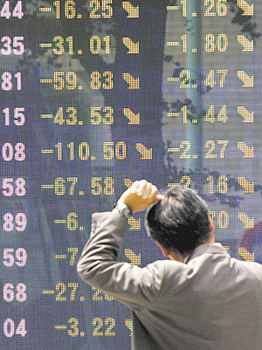
AFTER YEARS OF planning, politicizing, prognostication and a recession-inspired procrastination, stock futures trading has arrived in China.
The more sophisticated and mature financial product is intended to broaden investment options and hedging vehicles in the capital markets.
However, lack of clarity on how the new products will perform on China’s A-share markets helped drag the benchmark Shanghai Composite index down a point yesterday despite the release of wildly exuberant first quarter GDP growth figures.
A Chinese language story on SinaFinance offered useful insights into the new program and provided strategies on how to best deal with stock futures trading.
One strategy is for traders participating in stock futures trade to continue maintaining a heavier exposure to theme counters, especially in industrial sector shares.
This was especially true, coming on the back of yesterday’s economic growth figures which had China’s first quarter GDP jumping a surprising 11.9% year-on-year – not a bad start for yet another year in which Beijing is publicly expressing hopes of around an 8% expansion rate.
More telling among the National Bureau of Statistics figures was that industrial output expansion was off the charts with heavy industry expanding 22% and light industry 14%.
The report said that there was no reason to believe this critical sector of the economy would suddenly fall off the table, hence the recommendation that stock futures participants keep relevant counters in mind.
“It is expected that investors in the ChiNext (GEM) Board will be some of the early and most ambitious players in stock futures. We have seen the new board has attracted some of the most dynamic capital in China, with drastic up and down movement.
“Therefore, they will be looking for more product diversification and stability which is exactly what the securities watchdog is hoping stock futures will bring,” the report cited a market insider as saying.
The retreat of valuations on ChiNext in recent days may also convince investors of the wisdom of hedging and informed risk aversion.
Value Investing... with Chinese Characteristics
Another take on the inaugural day of stock future trading in China is that investors should avoid overexposure to any theme and pick and choose winners with long-term growth potential and value across a variety of sectors.

“A-shares have been all over the map these past couple of months, and ChiNext listcos have shown even more volatility. In general, moneymaking opportunities have diminished somewhat on these boards over the short term.
"A lot of this has to do with the rapid rise of property prices and the expectations that central authorities will take more proactive measures soon to reign in the sector. And of course, banks will be affected by this. So we still recommend those pondering a go at stock futures to look at each buy for its long-term potential, and on its individual merits,” the report said.
Finally, the report cited another market expert as saying that those pondering participation in the new program, which begins with the 9.30 am opening of trade on China’s A-share markets today, to not forget to keep an eye on macroeconomic figures.
Also, first quarter results should also be scrutinized and monitored because they are the best indicator of where a particular listed firm will be financially when futures contracts mature a few months down the road.
“I would strongly recommend that stock futures investors keep a very close watch on the CPI, which has a very intimate relationship with the performance of numerous stocks down the road – especially consumption and banking stocks.”

It also said that there is sufficient evidence to suggest that real estate developers in the provinces of Hainan and Tibet were attracting the most scrutiny from regulators due to their “over-fast” property price growth.
“At the end of the day, the government sees stock futures trading as a way to help curb short term speculation, so regulators are welcoming the new practice in order to assist in stabilizing the country’s capital markets to some degree.”
The launch of stock futures trading has long been eagerly anticipated by traders keen on the possibility of expanded investment options.
The country’s bourse watchdog – the China Securities Regulatory Commission (CSRC) – last month said it had approved stock futures trading to begin today on the Shanghai and Shenzhen exchanges.
The benchmark Shanghai-Shenzhen 300 Stock Index will be launched with strict adherence to regulations to “efficiently prevent market manipulation,” the CSRC said in a statement.Late last month, China launched a margin trading pilot program to bring more diverse investment instruments to the market.
The China Financial Futures Exchange official website said the first contracts to trade will by for May, June, September and December. Investors must pay cash deposits equal to 15% of the contract value for May and June contracts, with 18% deposits required for the longer-term contracts.
Related story: CHINEXT: GEM Board nosedives, 13 hit daily limit







